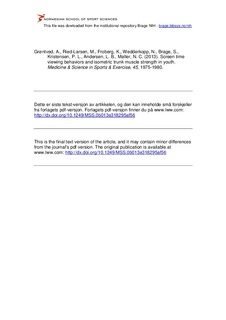| dc.contributor.author | Grøntved, Anders | |
| dc.contributor.author | Ried-Larsen, Mathias | |
| dc.contributor.author | Froberg, Karsten | |
| dc.contributor.author | Wedderkopp, Niels | |
| dc.contributor.author | Brage, Søren | |
| dc.contributor.author | Kristensen, Peter Lund | |
| dc.contributor.author | Andersen, Lars Bo | |
| dc.contributor.author | Møller, Niels Christian | |
| dc.date.accessioned | 2014-10-31T14:01:59Z | |
| dc.date.available | 2014-10-31T14:01:59Z | |
| dc.date.issued | 2014-10 | |
| dc.identifier.citation | Medicine & Science in Sports & Exercise. 2013, 45, 1975-1980 | nb_NO |
| dc.identifier.uri | http://hdl.handle.net/11250/225245 | |
| dc.description | I Brage finner du siste tekst-versjon av artikkelen, og den kan inneholde ubetydelige forskjeller fra forlagets pdf-versjon. Forlagets pdf-versjon finner du på www.lww.com: http://dx.doi.org/10.1249/MSS.0b013e318295af56 / In Brage you'll find the final text version of the article, and it may contain insignificant differences from the journal's pdf version. The original publication is available at www.lww.com: http://dx.doi.org/10.1249/MSS.0b013e318295af56 | nb_NO |
| dc.description.abstract | Purpose: The objective of this study was to examine the association of screen time viewing behavior with isometric trunk muscle strength in youth.
Methods: A cross-sectional study was carried out including 606 adolescents (14–16 yr old) participating in the Danish European Youth Heart Study, a population-based study with assessments conducted in either 1997/1998 or 2003/2004. Maximal voluntary contractions during isometric back extension and abdominal flexion were determined using a strain gauge dynamometer, and cardiorespiratory fitness (CRF) was obtained using a maximal cycle ergometer test. TV viewing time, computer use, and other lifestyle behaviors were obtained by self-report. Analyses of association of screen use behaviors with isometric trunk muscle strength were carried out using multivariable adjusted linear regression.
Results: The mean (SD) isometric strength was 0.87 (0.16) N·kg-1. TV viewing, computer use, and total screen time use were inversely associated with isometric trunk muscle strength in analyses adjusted for lifestyle and sociodemographic factors. After further adjustment for CRF and waist circumference, associations remained significant for computer use and total screen time, but TV viewing was only marginally associated with muscle strength after these additional adjustments (-0.05 SD (95% confidence interval, -0.11 to 0.005) difference in strength per 1 h·d-1 difference in TV viewing time, P = 0.08). Each 1 h·d-1 difference in total screen time use was associated with -0.09 SD (95% confidence interval, -0.14 to -0.04) lower isometric trunk muscle strength in the fully adjusted model (P = 0.001). There were no indications that the association of screen time use with isometric trunk muscle strength was attenuated among highly fit individuals (P = 0.91 for CRF by screen time interaction).
Conclusions: Screen time use was inversely associated with isometric trunk muscle strength independent of CRF and other confounding factors. | nb_NO |
| dc.language.iso | eng | nb_NO |
| dc.publisher | LWW | nb_NO |
| dc.subject | fitness | nb_NO |
| dc.subject | tv | nb_NO |
| dc.subject | computer | nb_NO |
| dc.subject | adolescents | nb_NO |
| dc.subject | sedentary | nb_NO |
| dc.title | Screen time viewing behaviors and isometric trunk muscle strength in youth | nb_NO |
| dc.type | Journal article | nb_NO |
| dc.type | Peer reviewed | nb_NO |
| dc.subject.nsi | VDP::Social science: 200::Social science in sports: 330::Other subjects within physical education: 339 | nb_NO |
| dc.source.journal | Medicine & Science in Sports & Exercise | nb_NO |
| dc.description.localcode | Seksjon for idrettsmedisinske fag / Department of Sports Medicine | nb_NO |
